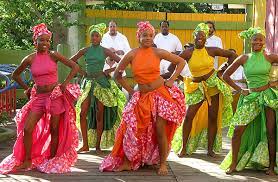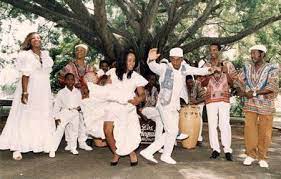LA GUARACHA & LA RUMBA CUBANA, SU SIGNIFICADO COMO EL DE “FIESTA”, “HOLGORIO”. PHOTOS.
Las palabras rumba y la Guaracha Cubana son términos abstracto que han sido aplicado con diferentes propósitos a una amplia variedad de temas durante largo tiempo.
Desde un punto de vista semántico el término rumba puede ser incluido en un grupo de palabras con similar significado tales como conga, milonga, bomba, tumba, samba, bamba, mambo, tambo, tango, cumbé, cumbia y candombe. Todas ellas denotan un origen congolés debido a la utilización de combinaciones de sonidos tales como mb, ng y nd, que son típicos del complejo lingüístico Níger-Congo.
Quizás el más antiguo y general de sus significados es el de “fiesta” u “holgorio”. Ya durante la segunda mitad del siglo xix podemos encontrar esta palabra utilizada varias veces con el propósito de representar una fiesta en un cuento corto llamado “La mulata de rumbo”, del folklorista cubano Francisco de Paula Gelabert: “…más gozo yo y me divierto en una rumbita con las de mi color y de mi clase…”, o “Leocadia iba a acostarse, como había dicho, nada menos que a las doce del día, cuando llegó a la casa uno de sus amigos de rumbas, acompañado de otro joven que iba a presentarle…”. Según Alejo Carpentier “…es significativo el hecho de que la palabra rumba haya pasado al lenguaje del cubano como sinónimo de holgorio, baile licencioso, juerga con mujeres del rumbo.”
Como ejemplo pudiéramos mencionar las fiestas de Yuka y Makuta, y los changüises en Cuba, así como la milonga y el tango en Argentina, donde la palabra rumba fue originalmente utilizada para denominar una reunión festiva; y con el trascurso del tiempo se usó para nombrar los géneros de música y danza correspondientes a estas festividades.
Algunos académicos han señalado que en cuanto a la utilización de los términos rumba y guaracha, nos encontramos ante un caso de sinonimia, es decir, del uso de dos palabras diferentes para nombrar una misma cosa.
En el siguiente comentario de María Teresa Linares se pone en evidencia la imprecisión de los términos rumba y guaracha en cuanto al propósito de definir un género musical específico, cuando nos dice que: “…en los primeros años de este siglo [XX], se mantenían al final de las obras del teatro vernáculo, unos fragmentos musicales que cantaban los propios autores y que se les llamó rumba final…” y continúa explicando que estas… “eran ciertamente guarachas.”
A lo que se pudiera añadir que a las piezas musicales que cerraban las obras se les podía haber llamado indistintamente rumbas o guarachas, ya que estos términos no indicaban ninguna diferencia genérica o estructural entre ellas. Linares también dice en referencia a este tema: “Se conservan grabaciones de los artistas del Teatro Alhambra de guarachas y rumbas que no se diferenciaban entre sí en el acompañamiento de las guitarras –cuando se trataba de un pequeño grupo, dúo o trío- o por la orquesta del teatro o piano. Las etiquetas de los discos decían: diálogo y rumba”.
LA RUMBA URBANA…
La Rumba Urbana (también llamada Rumba de Solar o de Cajón), es una amalgama de varias tradiciones musicales y danzarias africanas, combinadas con influencias hispanas.
De acuerdo con el musicólogo cubano Argeliers León: “En la fiesta que constituyó una rumba concurrieron, pues, determinados aportes afroides, pero convergieron también otros elementos, de raíz hispánica, que habían sido incorporados ya a las expresiones que aparecían en la nueva población que surgía en la Isla.
La Rumba de Cajón es un estilo de música seglar que surge en los muelles y las áreas menos prósperas de la Habana y Matanzas. En sus comienzos, los ejecutantes de la Rumba utilizaron un trío de cajones de madera para tocar, los cuales fueron sustituidos más tarde por tambores, similares en su apariencia a las congas o tumbadoras. El tambor más agudo es llamado “quinto”, el de tesitura media “macho” o “tres-dos”, debido a que su ritmo esencial está basado en el patrón de la clave cubana, y el más grave es llamado “hembra o salidor”, porque usualmente comenzaba o “rompía” la Rumba.
La Rumba de Solar o de Cajón es hoy día un género fósil que puede ser visto en Cuba en las presentaciones de grupos profesionales que se dedican al cultivo de este género. También existen grupos de aficionados radicados en las llamadas “Casas de Cultura”, y en centros de trabajo. Como todos los aspectos de la sociedad en Cuba, las actividades musicales y danzarias son organizadas por el estado a través de Ministerios y otros organismos.
THE CUBAN GUARACHA AND RUMBA, ITS MEANING LIKE “FIESTA” AND “HOLGORIO”. PHOTOS.
The words rumba and the Cuban Guaracha are abstract terms that have been applied for different purposes to a wide variety of topics for a long time.
From a semantic point of view, the term rumba can be included in a group of words with a similar meaning such as conga, milonga, bomba, tumba, samba, bamba, mambo, tambo, tango, cumbé, cumbia and candombe. All of them denote a Congolese origin due to the use of sound combinations such as mb, ng and nd, which are typical of the Niger-Congo language complex.
Perhaps the oldest and most general of its meanings is that of “party” or “holiday”. Already during the second half of the 19th century we can find this word used several times with the purpose of representing a party in a short story called “La mulata de rumbo”, by the Cuban folklorist Francisco de Paula Gelabert: “…I enjoy more and I have fun in a party with those of my color and class…”, or “Leocadia was going to bed, as she had said, at no less than twelve o’clock, when one of her partying friends arrived at the house, accompanied by another young man who was going to introduce him…”. According to Alejo Carpentier “…it is significant that the word rumba has passed into the Cuban language as a synonym for feasting, licentious dancing, revelry with women from the area.”
As an example we could mention the Yuka and Makuta parties, and the changüises in Cuba, as well as the milonga and tango in Argentina, where the word rumba was originally used to denote a festive gathering; and over time it was used to name the genres of music and dance corresponding to these festivities.
Some academics have pointed out that in terms of the use of the terms rumba and guaracha, we are faced with a case of synonymy, that is, the use of two different words to name the same thing.
The following comment by María Teresa Linares highlights the imprecision of the terms rumba and guaracha in terms of the purpose of defining a specific musical genre, when she tells us that: “…in the early years of this [20th] century, they kept at the end of the vernacular theater works, some musical fragments that the authors themselves sang and that were called final rumba…” and he goes on to explain that these… “were certainly guarachas.”
To which one could add that the musical pieces that closed the works could have been called indistinctly rumbas or guarachas, since these terms did not indicate any generic or structural difference between them. Linares also says in reference to this subject: “Recordings of the artists of the Alhambra Theater of guarachas and rumbas that did not differ from each other in the accompaniment of the guitars -when it was a small group, duo or trio- or by the theater orchestra or piano. The labels of the discs said: dialogue and rumba”.
THE URBAN RUMBA…
Urban Rumba (also called Solar Rumba or Cajon Rumba) is an amalgamation of various African musical and dance traditions, combined with Hispanic influences.
According to the Cuban musicologist Argeliers León: “In the party that constituted a rumba, certain Afroid contributions attended, but other elements also converged, with Hispanic roots, which had already been incorporated into the expressions that appeared in the new population that arose on the island.
La Rumba de Cajón is a secular style of music that emerges in the docks and less prosperous areas of Havana and Matanzas. In its early days, Rumba players used a trio of wooden cajons to play, which were later replaced by drums, similar in appearance to congas or tumbadoras. The highest pitched drum is called “quinto”, the one with medium pitch “macho” or “three-two”, because its essential rhythm is based on the pattern of the Cuban clave, and the lowest is called “female or salidor”. ”, because he usually started or “broke” the Rumba.
The Rumba de Solar or Cajón is nowadays a fossil genre that can be seen in Cuba in the presentations of professional groups that are dedicated to the cultivation of this genre. There are also groups of fans based in the so-called “Houses of Culture” and in workplaces. Like all aspects of society in Cuba, musical and dance activities are organized by the state through Ministries and other agencies.
Agencies/ Wiki/ RumbaGuarachaHist./ Extractos/ Excerpts/ Internet Photos/ Arnoldo Varona/ www.TheCubanHistory.com
THE CUBAN HISTORY, HOLLYWOOD.









